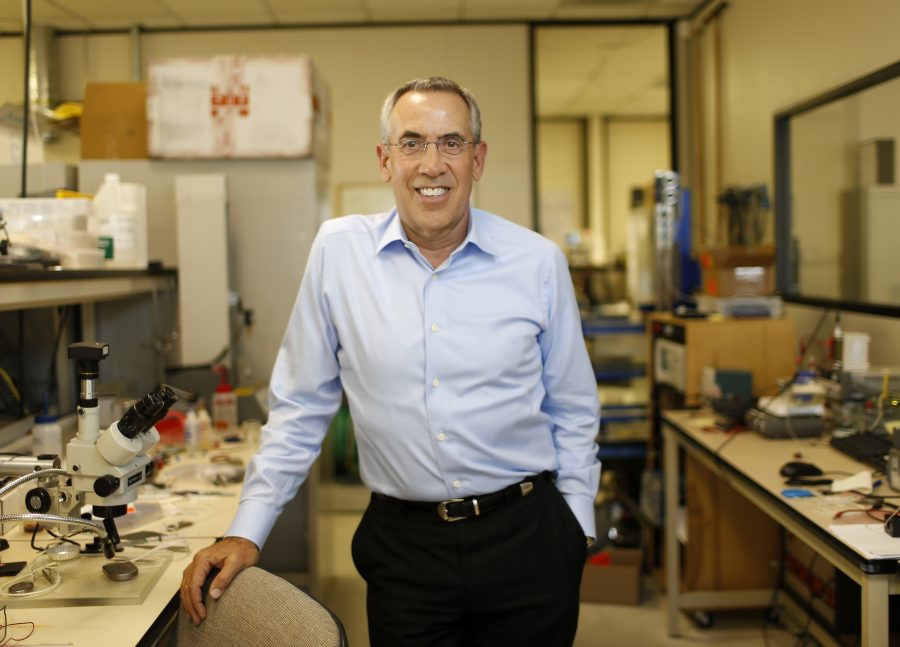Medical tech investor Allan Will betting on wireless pacemaker
Allan Will, president and CEO at EBR Systems, poses for a portrait in a lab in his offices on June 23, 2016 in Sunnyvale, Calif. (Nhat V. Meyer/Bay Area News Group/TNS)
October 11, 2016
SAN JOSE, Calif. — For decades, Silicon Valley health technology investor and operating executive Allan Will has successfully bet on some of the most innovative medical therapeutic devices created to improve, extend and save lives.
He’s been a serial CEO, founded the valley’s most prolific medical device incubator, is an executive chairman and inventor — including more than 30 patents ranging from catheters and stents to tools for harvesting blood vessels for heart surgery.
Among Will’s latest ventures is EBR Systems, which develops devices for cardiac rhythm management. In September, the Sunnyvale-based company’s WiSE technology — wireless stimulation endocardially — got the greenlight from the Federal Drug Administration for clinical testing of its rice-sized implantable pacemaker.
Instead of use pacing leads — something Will calls a decades-old technology with well-documented problems — the WiSE system implants a small wireless electrode. It is already approved in Europe for use in patients who have failed conventional cardiac resynchronization therapy, or CRT.
The wireless device converts ultrasound energy to electrical pulses that synchronize the heart’s large pumping chambers. By improving their performance, Will said, heart failure symptoms decline and mortality improves. The Mercury News talked to the 62-year-old Will about the new technology, why he thinks it’s a game-changer and who it will help. This interview has been edited for length and clarity.
Q: What does EBR stand for?
A: EBR is the initials of the company’s three founders: Debra Echt, an electrophysiologist type of cardiologist; Axel Brisken, an ultrasound physicist; and Rick Riley, a well-known executive and former pacemaker engineer from Medtronic.
Q: How did they come up with the idea?
A: They did it pretty much on the back of a napkin — the typical Silicon Valley story. Debra recognized that many of the shortcomings of conventional cardiac resynchronization therapy resulted from the wire leads required to pace the heart.
Q: What is cardiac resynchronization therapy, or CRT?
A: People with heart failure have a progressive, debilitating disease. Without therapy, they deteriorate and eventually die of the condition. For many, medicine doesn’t help much, which is why they get CRT, or pacemakers, that electrically stimulate the heart. CRT is also referred to as biventricular pacing because it uses wire leads to synchronize the left and the right ventricles so that the two chambers beat together.
Q: You said there is often a problem with the leads. Can you explain why?
A: When a patient gets a CRT system, they typically have three leads inside them. One lead goes into the right atrium, one into the right ventricle and one into the coronary sinus. Sometimes the doctor can’t get the coronary sinus lead into position. Other times, the lead migrates to a place that does not pace well, and in other cases, the lead fractures and actually breaks. Even when the doctor gets the coronary sinus lead placed, about 30 percent of the time, the pacing doesn’t work because that position doesn’t adequately stimulate the left ventricle, which is the heart’s main pumping chamber.
Q: How many people does this affect every year?
A: About 1.5 million people around the world suffer from their heart beating out of sync. Some have not reached a point in their disease where they need to have intervention. Other patients have gotten too ill to reverse the condition, so there are some who are not treated. About 200,000 patients are treated worldwide each year with conventional CRT, and about 155,000 of them are in the U.S.
Q: Why doesn’t a conventional CRT pacemaker work for them?
A: The coronary sinus is like a roadway system that only goes to certain locations outside the heart. It does not give you a complete choice of pacing sites. Many of these patients have had a heart attack, causing areas of the left ventricle’s muscle to die. That dead tissue disrupts the electrical pulse of the pacemaker.
Q: So what does EBR’s technology do?
A: We don’t use pacing leads. We implant a small wireless electrode — the size and shape of a grain of orzo — placed precisely inside the left ventricle to provide maximum benefit. Studies have shown that you may get a 20 percent improvement in blood flow by pacing inside the heart.
Q: Have other companies developed similar devices?
A: Similar, but their devices only stimulate the right ventricle. Until WiSE, no one has been able to make devices small enough to safely pace inside the left ventricle. It’s a challenging location because of the risk of blood clots or stroke.
Q: How much would the device cost a patient, and how long would it last?
A: Initially, about $20,000, which is similar to conventional CRT devices. It would last about four to six years before a new battery is required.
Q: How much money is at stake here?
A: Worldwide, about $3.5 billion is spent on conventional CRT devices alone. We know 30 percent of those fail, meaning $1 billion of devices are wasted annually. Add to that the cost of subsequent hospitalization to treat these failing patients, and the total waste easily exceeds many billions.
Q: If your WiSE device gets approved by the FDA, what does that mean for patients?
A: Conventional CRT helps 70 percent of patients. We’ve had 85 percent success treating patients who previously failed conventional devices. Considering our success in the failed patients, we may be able to eventually get an even higher overall success. That would mean more patients get treated because doctors would be more confident of successful outcomes. It would not only improve patients outcomes, but potentially lead to billions in savings for the healthcare system.
———
Allan Will
Education: Graduated from the University of Maryland with a bachelor’s degree in zoology; received a master’s degree in management from the Massachusetts Institute of Technology.
Position: CEO of EBR Systems; chairman of Fractyl Labs, a new endoscopic treatment for Type 2 diabetes, and Setpoint Medical, a neurostimulation device for debilitating inflammatory diseases; director of the Fogarty Institute for Innovation.
Previous jobs: Founding managing director in Split Rock Partners’ Silicon Valley venture capital office, focusing on the therapeutic medical device field; founder, chairman and CEO of The Foundry, an incubator dedicated to transforming medical device concepts into companies where he co-founded 11 companies; CEO of multiple successful medical device companies.
———
Five facts about Allan Will
1. He has volunteered for many years with the Network for Endangered Sea Turtles on the Outer Banks of North Carolina to mark sea turtle nests and stake them out for protection.
2. He’s taken his children on two cross-country trips visiting national parks, one in 1994 (14,000 miles traveled with three kids under 8 years old) and one in 1998 (11,000 miles).
3. In 2008 he was the recipient of the Deloitte Leadership in Mentoring Award for mentoring women executives awarded by Astia (aka the Women’s Technology Cluster).
4. Over his career, more than 30 executives and managers who worked for him have gone on to become medical device startup company CEOs.
5. One of his first jobs out of college was as a high school substitute teacher in everything from physics to English to cosmetology. He said it was the most tiring job he has ever had in his career.
———
©2016 The Mercury News (San Jose, Calif.)
Visit The Mercury News (San Jose, Calif.) at www.mercurynews.com
Distributed by Tribune Content Agency, LLC.
















